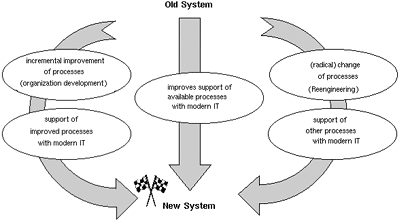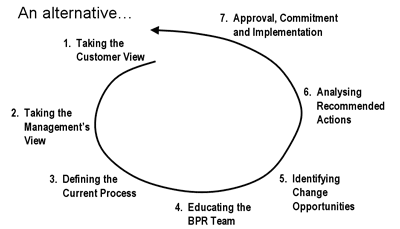Re-engineering Business Processes



 Mini Case-Study
Mini Case-Study
n 1995 the Ford Motor Company commenced an ambitious plan called Ford 2000, which included merging its North American, European, and international operations into a single global organization.
Ford 2000 called for dramatic cost reductions to be obtained by re-engineering and globalizing corporate organizations and processes.
By making processes and products globally common, Ford intended to eliminate organizational and process redundancies, and realize huge economies of scale in manufacturing and purchasing.
Ford’s new global approach required that technology be employed to overcome the constraints usually imposed by geography on information flows. Teams on different continents needed to be able to work together as if they were in the same building.
In almost every re-engineering project, I.T. emerged as a critical enabler.
The link between re-engineering success and the company’s I.T. groups was made explicit in the Ford 2000 restructuring – I.T. was placed within the process re-engineering organisation.

As Ford 2000 unfolded, the Internet revolution unfolded in parallel, creating new possibilities for re-engineering processes within and between enterprises.
Ford launched a public Internet site in mid-1995, and a company-wide intranet was launched in mid-1996. In January 1997 Ford had in place a Business-to-Business (B2B) capability through which the intranet could be extended in a secure manner beyond the company boundaries into an extranet, potentially connecting Ford with its suppliers.
Introduction 
Business process re-engineering (BPR) – also called business process redesign – is a combination of industrial engineering techniques, operations research methods, management theory, and information systems analysis methods that utilizes the power of information technology to transform business processes of corporations so that they can more effectively compete in their markets.
The need for businesses to rethink their processes is driven by the pressures of the modern global economy. Even though an individual company may operate regionally or locally, it cannot escape global competition because expanding national or international firms are continually invading new territories.
Definitions
Business Process Re-engineering (BPR) can be defined as the search for, and implementation of, radical change in business processes to achieve breakthrough improvements in products and services.
Re-engineering is the fundamental rethinking and radical redesign of business processes to achieve dramatic improvements in critical, contemporary measures of performance, such as cost, quality, service and speed.

Why Re-engineer?

Fundamental – BPR involves a new approach – instead of asking “How to….”, Re-engineering starts with the question “What business are we in?”
Radical redesign – this means getting down to the fundamental – where necessary throwing away the old, out of date rules – and recognizing that quality and innovation are more important to profit than cost.
Dramatic – BPR is not about making small improvements – it is about achieving quantum leaps in performance.
Processes – BPR is all about redesigning business processes for dramatic improvements. It is not about “patches” or incremental change, rather it is the major reworking of operations. BPR is about top-down change that is structural and planned with its focus on increased value as well as cutting costs.
 Basic Principals
Basic Principals
- Organize around processes and outcomes – not departments or tasks. An individual’s job design should be outcome based, and this outcome is their responsibility.
- The users of an outcome should perform the process. Too often one department is a customer of another.
- Have those who produce information process it.
- Decentralize and disperse data. This creates economies of scale and eliminates the redundancy needed to centralize operations.
- Integrate parallel activities. If the same task is done in several locations, it must be done in a single process that incorporates those functions unique to the previous system.
- Empower workers and use in-built controls. Within limits the people doing the work should be given the power to make decisions.
- Capture data once, at its source. Traditionally users have developed their own systems. This is inefficient, expensive, and often generates data discrepancies. Data sharing software reduces errors, delays and costs.
Re-engineering and Strategy - It is essential that the goals of re-engineering are aligned with the main objectives of the business, and are consistent with the strategic direction of the organisation.
Implementing BPR when it is not aligned with the organization’s strategy will be counterproductive!
 BPR is not...
BPR is not...
- A change to creates more problems.
- The overlaying of new ideas on top of the old “system”.
- Increasing power in an organisation.
- A panacea (something that cures everything).
- About incremental moves and changes.
- Reorganisation by another name.
- An event or project (or something to hang on the wall and look at)!
Resistance to BPR
BPR often requires that change is dramatic. This can be extremely threatening to employees, they will find it hard to adjust to, and they can create resistance to the change.
In BPR the new design of jobs has to be flexible and cross-functional, which is the true value of BRP. However, because employees often have to move from simple tasks to multi-dimensional work – creating redundancies – this can cause fear of an unstable work environment, and hatred towards the new processes.
Implementation Sequence
In performing re-engineering, a recommended sequence of events is to:
- Outline current processes and workflow, 2
- Search for superior process models, and
- Then find the resources, including information technology, to implement innovative new processes.

 Introducing BPR to an Organisation
Introducing BPR to an Organisation
To be truly successful, a BPR must be fully introduced. This will require:
- A holistic approach.
- Creative thinking.
- Willingness to take risks.
- Analysis of what is required to achieve a major change.
- Departure from departmental (or silo) thinking.
- Personalized approach to service.
- Customer able to talk to supplier.
Reasons why BPR can fail include:
- Lack of senior management support.
- Resistance to change.
- Poor scope and unrealistic expectations.
- Belief that BPR is (only) technology driven.
- Not involving the right people.
- Failure to understand the business processes.
- Failure to understand that BRP is a strategic approach.
- Lack of experience.
- Lack of planning and performance measurement.
Benefits of BPR
- Increases in the process capacity by creating a more favourable cost structure and by providing better competitive positioning.
- Increases in sales demand by creating/satisfying demand for existing or new products.
- A BPR can create an environment that gets people to work together to achieve a common goal. The achievement of the common goal usually means a resultant benefit to the whole organization.
- BPR can bring about profound change by giving its people the tools, the information and the authority to produce substantial improvements in the information flow that otherwise would have been impossible.
- Significant increases in co-operation between staff, increased focus, higher quality of output at all stages – not just a finished product.
- BPR gives an organization a fresh start – a new chance to critically evaluate how things are done.
Thinking Differently
BPR requires a paradigm shift to be successful:
- Productivity of knowledge – I.T. enables a high performance model.
- Quality – especially consistency and predicability which are achieved by employee motivation, supplier involvement, and performance measurement.
- Responsiveness – minimising the time lag between opportunity and response.
- Globalisation – treat the world as a marketplace by taking advantage of communication technology and e-business.
- Outsourcing – the reliance on outsource is dependant upon a greater reliance on I.T.
- Alliances – research consortia, EFT between banks and shops via EFTPOS, and the mentality of “barriers” lasts longer than the actual wall.
- Social and environmental responsibilities – the bottom line ($’s) is being replaced by the triple bottom line (society, the economy and the environment).
Problems associated with BPR
- BPR requires a large investment in resourcing – for example it generally requires a 30-50% increase on the current training budget to retrain workers from being specialists to being generalists.
- New practices will infringe upon the employees comfort zone, leading to resistance to change. The final success of a BPR initiative depends upon gaining the early and full support of workers.
- Corporate culture can be a problem, especially where there is a highly structured, hierarchical organisation.
 Role of I.T.
Role of I.T.
I.T. plays an important part in BPR. However, simply “throwing” computers at business problems will often not help solve the problem. Rather, I.T. is an essential enabler to make BPR happen. In most cases, without technology, BPR will not be possible.
I.T. does not drive BPR, rather it is an essential component of the BPR solution.
The role of IT can be summarised as:
- Help centralize processing.
- Add value.
- Be part of change management.
- Be a champion of BPR.
- Be active in executive management.
- Provide cost justification guidelines for I.T. purchasing.
- Help with the seamless integration of new processes.
- Participate in Multifunctional teams.
- Demonstrate that I/.T. can build better systems, faster.
- Custodian of the corporate I.T. architecture. 11. Assist in strategic alignment.
 Team Tactics for BPR
Team Tactics for BPR
One of the key issues when planning a BPR initiate is to ensure that the right mix of people are involved at the right time.
Ideally the team will be composed of a small group of high quality, full time resources with part-time experts introduced as required.
Involvement in the BPR team should be view as a positive career move – not as a dumping ground for poor performing or unassigned employees.
The re-engineering team should be a mixed group that includes an I.T. representative. It should also include:
- Some members with no knowledge of BPR.
- Some members with solid experience in BPR.
- Customers or client representatives.
- Representatives from impacted staff.
- Passionate and committed staff
- Some members from outside the company.
 Role Management
Role Management
BPR aims to simultaneously change processes, technology, job roles and organizational culture! This will only be successfully achieved if there is strong and consistent support from executive management – especially in terms of money, resources and leadership.
In particular top management have a key role in helping to decide what are the core processes that contribute value to the business, and are therefore are priority areas for BPR.
Success Factors
More than half of the “early” re-engineering initiatives failed to be completed or did not achieve bottom-line business results.
For this reason BPR success factors have become an important topic.
These success factors are the collection of lessons learnt from BPR initiative – from which common themes emerge.
- Top management sponsorship – strong and consistent involvement.
- Strategic alignment – with organizations strategic direction.
- Compelling business case for change – with measurable objectives.
- Proven methodology – with a vision process.
- Effective change management – for cultural transformation.
- Line ownership – with accountability.
- Re-engineering team composition.
 Conclusion
Conclusion
BPR is a means of analyzing and assisting a business to reinvent itself.
However, in using BPR, “one size does not fit all” – and variations and allowances must be built into a BPR framework.
Correctly applied BPR adds a significant edge to a business’s competitive position in the market.
What do you know? What do you need to know?
For reading and review quesions - this is your chance to discuss answers with your lecturer.


